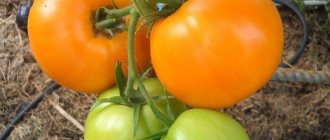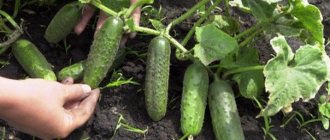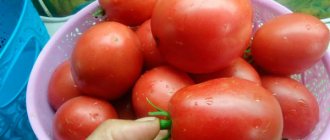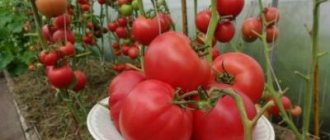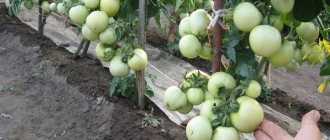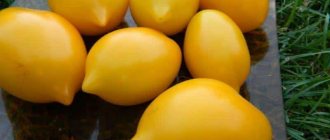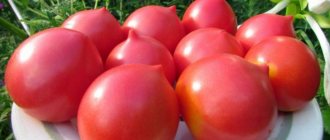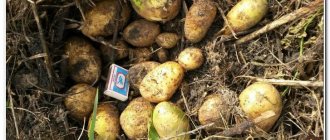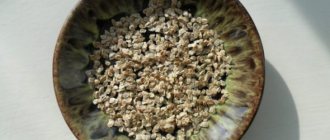Home / Vegetable garden / Tomatoes
Back
Published: December 24, 2018
Reading time: 11 min
0
You can rationally use the space of a greenhouse or small garden beds with the help of tall varieties of tomatoes. More labor-intensive care, compared to compact varieties, is compensated by high and long-lasting productivity. We bring to your attention an overview of the most interesting indeterminate varieties and hybrids, with detailed descriptions and nuances of cultivation.
- 1 Features and benefits
- 2 Varieties for greenhouses
- 3 Varieties for open ground
- 4 Earliest varieties
- 5 Yellow varieties
- 6 Varieties with unusual shape and color
Features and Benefits
Tall tomato varieties require special agricultural practices. The ripening of fruits occurs in parallel with the growth of shoots, which requires a large amount of nutrients. In order not to be disappointed in the yield, you should not deny such tomatoes additional fertilizing.
Indeterminate varieties do not stop shoot growth after the formation of a certain number of fruit clusters. Therefore, long stems need to be tied to a support. In addition, the gardener is required to constantly monitor his stepsons. Growing lateral shoots take away the plant's strength and prevent normal lighting and ventilation of the shoots.
Indeterminate and determinate varieties: what is the difference and which is better
Indeterminate tomatoes are not limited in growth; their height reaches 3-4 m . Determinate, on the contrary, have limited growth and form only a certain number of lashes. Determinate varieties are easier to care for; they do not require staking or pinching. Whereas indeterminate plants need to be tied up to get the best harvest.
Which one to choose depends on the personal preferences of gardeners . Some people prefer compact crops, but for greenhouses they often choose tall varieties that give higher and more stable yields.
Varieties for greenhouses
- One hundred pounds. A very productive bush with large tomatoes (300 g), collected in clusters of 3-5 pieces. Valued for its long-lasting yield. Ripe tomatoes are characterized by pronounced ribbing, crack-resistant skin and a rich scarlet color. From the bush you can collect up to 5 kg of fleshy, sweet tomatoes with slight sourness. Seedlings are formed into 1-2 stems, the stepsons are removed and provided with support.
- Sugar Bison. A domestically selected variety that quickly attracted the attention of gardeners with its unusually tasty fruits and high yield. With proper agricultural technology, up to 10-12 kg of large (up to 600 g) pink-raspberry tomatoes ripen on the bush. The shape of ripe tomatoes is round, slightly flattened at the stalk. A versatile vegetable.
- De Barao. A late, low-leaf tomato variety for cultivation exclusively in closed ground. The fruits, characteristically plum-shaped, are distinguished by a very dense skin, thanks to which they can be stored for a long time after picking. The color of the pulp is red, the taste is rich.
- Cossack girl. The variety is famous not only for its productivity, but also for its unusually decorative appearance of the bushes. On tall stems there are long fruit clusters strewn with miniature tomatoes. Barrel-shaped cherry-colored tomatoes grow up to 40-50 g. Sweet, juicy fruits are good fresh. The variety is not suitable for pickling and storage due to its thin skin, which easily bursts.
- Krasnobay F. Late hybrid with perfectly smooth tomatoes weighing up to 500 g. Differs in immunity to common diseases of the Solanaceae family. With proper care, it produces up to 40 kg of fruit per 1 m2. The first brush is tied quite high, after the formation of 11-12 leaves. It is recommended to pinch the ovaries, leaving no more than 4-5 flowers. The bushes are grown into 1 stem, removing all lateral shoots. Ripe tomatoes have a characteristic aroma and pleasant taste.
- Ilyich F. The hybrid is famous for its resistance to diseases, recommended for cultivation in the Moscow region and central Russia. Harvesting begins after 3-3.5 months. Tomatoes weighing 130-150 g acquire a bright orange-scarlet color as they ripen. They are valued by gardeners for their dense, sweet pulp with several seed chambers. There is a slight sourness in the taste. During the season, Ilyich gives up to 5 kg of mature tomatoes of universal use from 1 bush.
On a note! When planting tall tomatoes for greenhouses, you should follow the planting pattern recommended by the manufacturer. The distance between bushes depends on the characteristics of the root system and the degree of foliage of the variety.
Pros of tall tomatoes
All tall tomatoes are indeterminate, that is, their growth is not limited by the flower cluster, like low-growing tomatoes. The stem grows upward throughout the growing season and can reach a height of 3-3.5 meters. In heated greenhouses and regions with a warm climate, such tomatoes grow and bear fruit for more than a year, but in open ground this period is much shorter. For normal fruiting, tall varieties of tomatoes must not only be tied up, but also the bushes must be formed correctly.
It is important to correctly perform bush formation and garter
Indeterminate varieties of tomatoes
The main advantages of indeterminate tomatoes:
- high yield. When grown vertically, the plant forms from 20 to 40 fruit clusters, which makes it possible to collect 2 buckets of tomatoes per square meter;
- resistance to late blight. Plants tied to a trellis receive more air, are more evenly illuminated by the sun, and leaves and shoots do not have direct contact with the soil. As a result, bushes are affected by late blight much less frequently;
- long fruiting. Unlike determinate varieties, characterized by rapid ripening, tall tomatoes bear fruit from July to late autumn, maintaining the quality of the fruit throughout the entire period;
- ease of care. When forming a bush, all stepsons are removed, as a result of which the plant is not thickened, is clearly visible and is easy to handle if damaged by pests. Loosening and watering the soil at the roots is also convenient due to the absence of side shoots, and you don’t need to bend down when harvesting.
Tall tomatoes have many advantages
Varieties for open ground
- Cio Cio San. The variety has earned recognition from gardeners for its good yields, immunity to late blight and viral diseases. Tall, 2-meter branched stems must be tied to a trellis. Numerous fruit clusters, reminiscent in structure of grapes, are tied on the bushes. Cream-shaped fruits rarely exceed the 40 g weight mark. The color of the pulp and peel is pink-scarlet. Fruiting begins after 3-3.5 months.
- Crimson Giant. A mid-early variety with an extended harvest period. In the middle zone, the fruits are often set until the end of August and ripen after being removed from the branch. Ripe tomatoes have a sweet taste, aromatic and dense raspberry-colored pulp. Each fruit cluster ripens up to 5-6 tomatoes, weighing from 300 g. To increase productivity, it is recommended to form the bushes into 2 trunks and remove the lower shoots to 1 cluster.
- Tarasenko 2. A productive, cold-resistant hybrid that is rarely susceptible to disease. Multiple clusters produce up to 25-30 perfectly even tomatoes with a spout at the top. The average weight of each is 60 g. According to reviews from gardeners, Tarasenko 2 is excellent for harvesting, especially for pickling. Ripe tomatoes have a pleasant taste when fresh and tolerate transportation well. It is advisable to form bushes with 3 stems.
- Koenigsberg. The Siberian selection variety is resistant to weather vagaries such as cold and heat. The root system going deep into the soil allows the plants to tolerate drought well. Therefore, the variety is equally suitable for different regions. The bushes lead into 2 stems, providing support. The fruits are elongated, red, of different sizes. Weight on the lower branches is up to 700 g, on the upper branches no more than 200 g. Valued for its taste and characteristic aroma.
- Ira. Tall bushes of the hybrid can reach 3 m. The tomatoes are strewn with clusters of miniature fruits weighing 30 g. Ripe tomatoes are used for pickling and canning, and serve as a decoration for fresh dishes. The bushes form numerous lateral shoots, which must be removed in a timely manner. The fruits are characterized by a barrel-shaped shape, dense peel and sweet pulp. Productivity often exceeds 15 kg/m2.
Tall tomatoes need frequent and abundant watering. To reduce moisture evaporation, it is recommended to mulch the soil in tomato beds. A layer of dried straw will not only save time on watering, but also protect against weeds.
De Barao family
If previously it was believed that tall tomatoes of the De Barao variety were intended for growing in greenhouses, now they have conquered open space.
De Barao fruits are small, approximately 80-85 grams. They are all the same ellipsoidal shape, so they are often used for pickling.
They come in several colors - red, pink, yellow, black. Seedlings are planted in open ground from mid-May to mid-June, when the danger of return frosts has passed. When planting, place a handful of humus or peat in the hole. Further care comes down to timely watering, loosening, and tying up the stems.
From one bush during the season you can collect up to 8-10 kilograms of fruit. They are dense, fleshy, and sweet in taste.
Earliest varieties
Despite the fact that mid-ripening varieties and hybrids are more common among indeterminate tomatoes, there are varieties that allow you to begin harvesting in just 90-100 days.
- Wild Rose. An early salad variety, resistant to weather fluctuations and diseases. The flat-round, pink fruits reach 500 g. The juicy pulp with slight sourness is used for salads and making tomato juice. Agricultural technology involves pinching and tying to a trellis. The yield of the variety does not decrease even on saline soils.
- Miracle of the Earth. An early-ripening tomato that gardeners love due to the excellent taste of large fruits. Individual specimens on the lower branches reach a mass of 1-1.2 kg. The thick skin protects the tomatoes from cracking in rainy weather and during transportation. The pulp and peel of ripe fruits have a crimson color. The taste is delicate, dessert. It is recommended to form the plant into 1-2 stems and place no more than 3 bushes per 1 m2.
- Verlioka. An early ripening hybrid that is recommended to be grown in protected ground. It deserves attention due to its unpretentiousness and resistance to fungal and viral diseases. The yield of the hybrid cannot be ignored. When formed into 1 stem, with the growth point moving to a lateral shoot, each bush produces up to 4.5 kg of fruit. The compact size of ripe tomatoes (90-100 g) allows them to be used for whole-fruit preparations.
- Magic cascade. A hybrid for cultivation in protected ground grows 2 m in height. Weakly leafy shoots are hidden behind long tassels strewn with sweet tomatoes. One vine can simultaneously bear up to 40 fruits of rich scarlet color. In addition to high yield (16-18 kg/m2), it is resistant to tobacco mosaic and verticillium wilt. Cherries do not crack during long-term storage and transportation.
Cardinal
Classic tall tomato for open ground. It begins to ripen in early August.
The height of the bush is 1.5 meters, so it requires a mandatory garter to the trellis. Once every 10 days it is pruned and excess leaves are picked off. Watering an adult bush is carried out once a week at the root. The fruits of Cardinal are red, fleshy, and heart-shaped. There are few seeds inside.
Tomatoes grow weighing up to 500 grams or more, but at the end of the fruiting period they become smaller and weigh 250-300 grams.
Cardinal is immune to many diseases and temperature changes, does not crack, but is not stored for a long time. Therefore, it is processed into juice or fruit drink.
Yellow varieties
The sunny color of the fruit has an attractive appearance. Among the advantages of yellow-fruited tomatoes there is another important characteristic. These varieties are suitable for people with allergic reactions to red and pink tomatoes.
- A mystery of nature. A productive variety with fruits of unusual color. Yellow tomatoes flattened at the base are covered with a pinkish cap. A similar color is characteristic of sweet pulp. A tall trunk with heavy fruit clusters must be supported. With proper agricultural technology, you can harvest over 15 kg/m2.
- Amana Orange. The variety for greenhouse cultivation has a light fruity aroma and sweet taste. Another characteristic feature is the almost complete absence of seeds in the orange, dense pulp. Needs regular removal of stepsons. You can harvest after 3.5-4 months. The weight of the fruit on the first clusters reaches 0.8-1 kg.
- Honey drop. Decorative mini pear-shaped tomatoes will appeal to lovers of sweet tomatoes. The fruits are collected in clusters of 10-15 pieces. The advantages of the variety include immunity to late blight and blackleg, the ability to tolerate short-term drought and temperature fluctuations. Honey drops look beautiful in jars and on the table.
- Honey Spas. An excellent salad variety of tomatoes with high immunity to late blight and fusarium. Large fruits of bright yellow-orange color ripen in 110-120 days. The name of the variety reflects the high taste of ripe tomatoes without sourness. One bush produces approximately 5 kg of tomatoes per season.
How to choose a variety for your garden
Growing tomatoes begins with selecting the most suitable variety. To choose the right variety of vegetables, you need to familiarize yourself with the list of factors that are taken into account when choosing:
- Color and shape of fruits. Some people want their garden to be beautiful and select varieties based on the appearance of the fruit. They can have a flat-round, oval and rounded shape. At the same time, they can be painted red, yellow, burgundy or green.
- Purpose. Gardeners are engaged in growing vegetables to obtain a tasty harvest. Tomato fruits can be used for various purposes. Some varieties are suitable for preparing preparations for the winter, while others can only be eaten raw.
- Duration of ripening. When choosing a variety, be sure to take into account the length of the growing season. In order to harvest earlier, early-ripening varieties are planted. People who want to harvest ripe fruit later can choose vegetables with a longer growing season.
See also
Rules for sowing tomatoes in boiling water, advantages and disadvantages of the procedure
Read
Varieties with unusual shape and color
Along with traditional varieties, breeders delight gardeners with varieties of tall tomatoes in original colors and shapes.
- Casanova. A productive variety for protected soil with elongated, scarlet-colored fruits. The length of ripe tomatoes reaches 20 cm. They are valued for their pronounced tomato taste and keeping quality. During the season it produces about 12 kg/m2 of tomatoes. According to reviews from gardeners, it has sugar pulp without voids and a dense skin. Ideal for winter preparations. The shape and size of the fruit allows you to place whole tomatoes in jars. When fresh, the taste is inexpressive.
- Black pear. Attracts attention with the decorative shape of the fruit, reminiscent of a pear and unusual colors. When ripe, the peel has a glossy burgundy-brown color. The sweet pulp is characterized by a high content of carotene and ascorbic acid. Recommended for planting in sunny areas. Refers to varieties of medium ripening.
- Accordion pink. A variety with pronounced ribbing of the fruit from the base to the top. Ripe tomatoes weigh 250-300 g and are pink in color. Suitable for salads and fresh snacks. Tall bushes require support in the form of trellises and pinching. To increase productivity, the plant is formed into 2 stems.
- Emerald apple. A distinctive feature of the mid-season variety is the yellow-green color of ripe fruits. The taste has a slight sourness. The pulp is sweet and juicy. Tomatoes are covered with glossy skin that is resistant to cracking. In central Russia, planting in a greenhouse is recommended. Side shoots are promptly removed, forming bushes with 2 stems.
- David's Pineapple. According to the manufacturer's description, the variety belongs to white-fruited tomatoes. When ripe, the top of large (300-400 g) tomatoes is covered with a pink coating. The pulp is characterized by a pale color and a sweetish taste with fruity notes. Valued for its unusual appearance and aroma. The disadvantages of the variety include short storage.
Whatever variety of tall tomatoes is grown on the site, it should be remembered that compliance with agricultural practices affects the yield and taste of the fruit. Tall bushes need support, removal of shoots, regular feeding and watering.
Proper planting of tall tomatoes in a greenhouse
It is recommended to plant tomatoes in seedlings . Seedlings are prepared 60-65 days before planting in the greenhouse. To do this, pour soil into a container and make small holes in it. Place 2-3 seeds in each furrow, sprinkle with soil and water. Until planting, the seedlings are kept in a warm and sunny place, watered once every 5 days. Two weeks after planting, fertilize with liquid manure or chicken droppings.
Before planting in the ground, the greenhouse is thoroughly washed with water and a solution of potassium permanganate added. This composition disinfects the walls and doors of the greenhouse and destroys dangerous microbes. The beds are made 60-80 cm wide. For each bed, seedlings are planted in one row. The depth of the hole is 25 cm; before planting, potassium fertilizers are added to each hole.
Effective cultivation indoors
Water tall tomatoes in the morning or evening to avoid condensation on the surface of the structure. 1 bush consumes 1.5 liters of water. If the summer is hot, then the amount of water is reduced. Overwatering leads to diseases and the development of fungus.
Once every 2-3 days it is recommended to spray the stems and leaves with nettle infusion from a spray bottle. In addition to watering, special attention is paid to fertilizing.
Beneficial effect on tomato yield:
- manure or bird droppings;
- peat, humus, vermicompost;
- wood ash and river sand;
- potassium superphosphate, ammonium nitrate, potassium salt.
Bushes are formed into one or two stems, depending on the variety. Formation increases yield and stimulates fruit development: weak side shoots are removed and the tops are pinched to stop growth. When the first tomatoes appear, the stems are tied to a support. For example, to a wooden peg using a strip of fabric. If you do not tie up the bushes, the stems will break under the weight of the fruit.
What varieties of tomatoes are best to plant for pickling?
Most tomatoes are suitable for pickling. However, among them there are those that are good only for salads, and there are those that are only for pickling. Here are some of them.
Koenigsberg
Koenigsberg is a high-yielding indeterminate plant. Height 2 meters. Ripening occurs after 115 days.
Fruit weight is 150-300 grams. One brush produces 6 fairly large tomatoes. Productivity per square meter is 20 kg
Pickling miracle
The tomato is determinate, reaching a height of 0.45 to 0.5 meters. Ripening occurs in 80-100 days.
From 10 to 15 fruits ripen on a cluster. The fruits are round in shape, weighing 90-110 g, the pulp is sweet. Excellent for pickling, as its name suggests.
Pickling delicacy
The same determinate tomato, the height of the bush is no more than 1 meter.
5-8 fruits are formed on the cluster, which are red in color, plum-shaped, weighing 100-110 g. The yield is 3.5 kg.
Rocket
And another interesting variety of determinate type. The height of the bush reaches 0.4-0.6 meters. Ripening occurs in 115-125 days.
The fruits are elongated and weigh 50 grams. You can collect 6.5 kg per square meter.
Tips for the gardener
A successful selection of optimal varieties and hybrids of tomatoes suitable for greenhouse cultivation is not a 100% guarantee of obtaining rich fruit yields of commercial quality. To guarantee success, you will need to study in detail the agricultural techniques used when growing quality tomatoes indoors. For example, find out when to sow seeds so that the seedlings grow strong.
In particular, plants need to be provided with proper care, including state-of-the-art watering, fertilizing, loosening the soil, shaping, tying up bushes, preventive treatment against pests and diseases, and regular ventilation of the greenhouse space. Also, you will need to remove the ripened fruits in a timely manner to give the rest of the tomatoes on the bunches a chance to grow and ripen.
A correctly implemented set of agrotechnical measures will ensure high yields of greenhouse tomatoes. As a result, the gardener will be rewarded with a bountiful harvest of excellent tomatoes, which will be an excellent addition to the household’s diet and will arouse the envy of the neighbors. As you gain experience, over time you can count on making a good profit from selling greenhouse tomatoes - beautiful, tasty, healthy.
Tomatoes with thick skin
Tall varieties of tomatoes for greenhouses with thick skin should be chosen if the crop is planned to be transported over long distances and stored for a long time.
You can opt for the following popular types of vegetables such as tomatoes:
- "Krasnobay F1" is a hybrid variety that produces a fairly early harvest. The vegetables are strong, deep red and weigh up to 150 g. Each plant cluster usually contains up to 8 pieces. In order to increase the mass of vegetables, gardeners often leave 2-3 flowers on each branch. As a result, the weight of tomatoes reaches 300 g.
- "Akatuy F1" is a mid-early species that will be an excellent choice for greenhouses. The fruits are bright red in color. Up to 6 pieces are formed on each brush. The weight of the fruit reaches 140 g. These tomatoes are not very juicy, but their taste is very sweet.
- “Queen Margot F1” is an unusual variety of tomatoes, as their shape resembles cherries, and their weight rarely exceeds 15 g. This type belongs to the cherry group. It will be an ideal choice for canning and decorating dishes. However, you can use these tomatoes for making salads.
Almost any soil is suitable for growing these types of tomatoes. Exception: soils with high acidity. In this case, their preliminary preparation will be required.
You will need to add lime or special chemicals to the soil to reduce acidity.
What should be the feeding and garter?
Tomato plants are fertilized with mineral fertilizers and organic matter. Nitrogen is added 2 weeks after planting, phosphorus fertilizer is added during flowering, and potash is added for fruit growth. Fertilize with organic fertilizers after flowering approximately once every six months. You can feed tomatoes with fermented weeds.
Advice from gardeners: to speed up ripening, place a bucket of humus or manure in the greenhouse; the carbon dioxide released will stimulate the filling and setting of fruits.
You need to tie it to a trellis and pull it up as it grows. If you grow large-fruited tomatoes, then provide enhanced support. Do not forget to remove the stepsons from the leaf axils.
What varieties of tomatoes are best to grow in the Moscow region?
The climatic conditions of this region are considered temperate continental. It is here that the transition from the mild European continental climate to the harsher Asian climate occurs.
Winters here are not too cold, and summers are quite warm. All this allows us to achieve good harvests. In accordance with climatic conditions, the varieties selected here are slightly different than in the North. Here is a sample list of them:
- Alenka is an early ripening hybrid. Ripens in 3 months. The bushes grow up to one meter. The fruits weigh up to 200-250 g. The yield is 13 kg per 1 sq. m.
- French grapevine is a mid-season fruitful plant. The fruits weigh from 80 to 100 g. Resistant to diseases, does not sap. The fruits are used for pickling.
- Explosion is a high-yielding determinate tomato. The bushes are low-growing, but due to the large fruits it is necessary to make a garter. Resistant to root and crown rot.
- Angelica is an early tomato, super-determinate, grows up to 60-70 cm. Ripening occurs in 90-95 days. 8-10 fruits ripen in a cluster, weighing 60-70 g each.
- Upstart is an early ripening variety. The bush reaches a height of 80-100 cm. The weight of tomatoes is 70-110 grams.
Spring in the Moscow region comes at the end of March, and threats of frost are possible until mid-May. After this time, you can already start transplanting seedlings into greenhouses and greenhouses.

